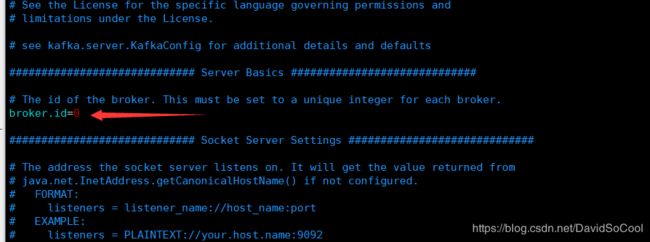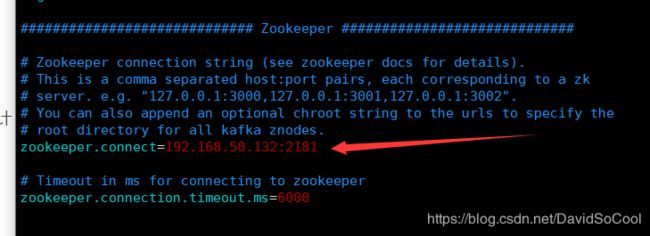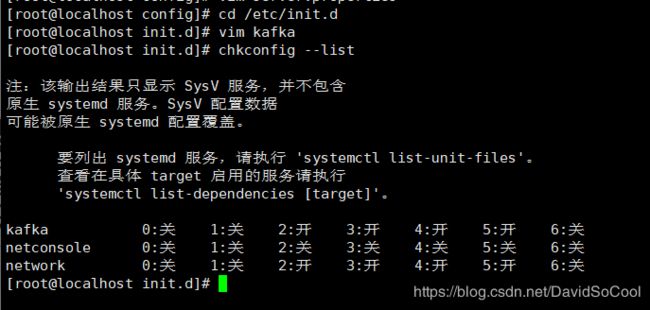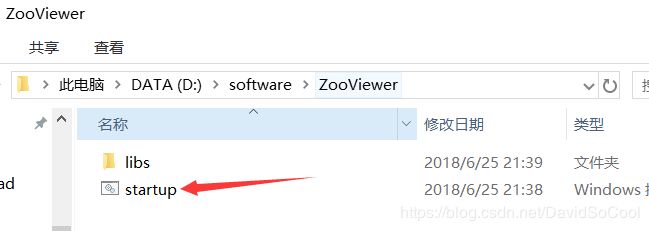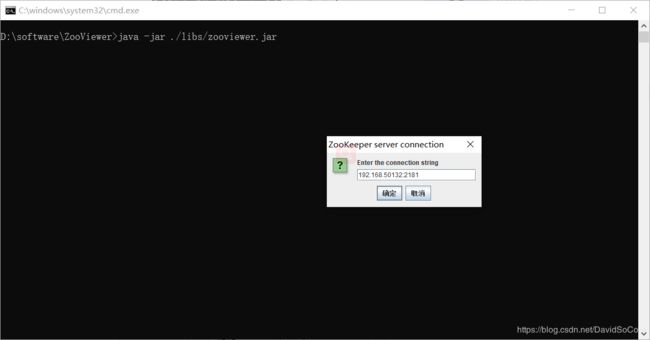虚拟机搭建kafka集群(Center OS 7)
操作系统:center os 7
软件:jdk8、zookeepe-3.5.5、kafka2.2.0
zookeeper集群部署:https://blog.csdn.net/DavidSoCool/article/details/96431181
kafka下载地址:https://www.apache.org/dyn/closer.cgi?path=/kafka/2.2.0/kafka_2.11-2.2.0.tgz
把下载好的kafka压缩包上传到服务器
#解压
tar -zxvf kafka-2.2.0-src.tgz
#进入 kafka的文件夹,刚加压的是没有logs文件夹的,我的有是因为启动过会自动创建
cd kafka_2.11-2.2.0/进入config文件夹,修改配置文件server.properties文件
cd config
#编辑配置文件server.properties
vim server.properties配置文件有四个地方需要修改。
第一个是broker.id,这个是集群中服务的唯一编号,第二台kafka就是1一次类推
第二个是listeners,原:#listeners=PLAINTEXT://:9092),修改后如图,加上的ip是当前服务器的ip地址,用于集群间的通信,监听消息收发。
第三个是日志文件夹,默认是在/tmp/kafka-logs这个文件夹会被清空,所以要修改成其他的,修改后的文件夹启动后会自动创建
第四个是zookeeper的注册地址,默认是使用本机的,修改为远程服务
修改后的配置文件
# distributed under the License is distributed on an "AS IS" BASIS,
# WITHOUT WARRANTIES OR CONDITIONS OF ANY KIND, either express or implied.
# See the License for the specific language governing permissions and
# limitations under the License.
# see kafka.server.KafkaConfig for additional details and defaults
############################# Server Basics #############################
# The id of the broker. This must be set to a unique integer for each broker.
broker.id=0
############################# Socket Server Settings #############################
# The address the socket server listens on. It will get the value returned from
# java.net.InetAddress.getCanonicalHostName() if not configured.
# FORMAT:
# listeners = listener_name://host_name:port
# EXAMPLE:
# listeners = PLAINTEXT://your.host.name:9092
listeners=PLAINTEXT://192.168.50.135:9092
# Hostname and port the broker will advertise to producers and consumers. If not set,
# it uses the value for "listeners" if configured. Otherwise, it will use the value
# returned from java.net.InetAddress.getCanonicalHostName().
#advertised.listeners=PLAINTEXT://your.host.name:9092
# Maps listener names to security protocols, the default is for them to be the same. See the config documentation for more details
#listener.security.protocol.map=PLAINTEXT:PLAINTEXT,SSL:SSL,SASL_PLAINTEXT:SASL_PLAINTEXT,SASL_SSL:SASL_SSL
# The number of threads that the server uses for receiving requests from the network and sending responses to the network
num.network.threads=3
# The number of threads that the server uses for processing requests, which may include disk I/O
num.io.threads=8
# The send buffer (SO_SNDBUF) used by the socket server
socket.send.buffer.bytes=102400
# The receive buffer (SO_RCVBUF) used by the socket server
socket.receive.buffer.bytes=102400
# The maximum size of a request that the socket server will accept (protection against OOM)
socket.request.max.bytes=104857600
############################# Log Basics #############################
# A comma separated list of directories under which to store log files
log.dirs=/tmp/kafka-logs
# The default number of log partitions per topic. More partitions allow greater
# parallelism for consumption, but this will also result in more files across
# the brokers.
num.partitions=1
# The number of threads per data directory to be used for log recovery at startup and flushing at shutdown.
# This value is recommended to be increased for installations with data dirs located in RAID array.
num.recovery.threads.per.data.dir=1
############################# Internal Topic Settings #############################
# The replication factor for the group metadata internal topics "__consumer_offsets" and "__transaction_state"
# For anything other than development testing, a value greater than 1 is recommended for to ensure availability such as 3.
offsets.topic.replication.factor=1
transaction.state.log.replication.factor=1
transaction.state.log.min.isr=1
############################# Log Flush Policy #############################
# Messages are immediately written to the filesystem but by default we only fsync() to sync
# the OS cache lazily. The following configurations control the flush of data to disk.
# There are a few important trade-offs here:
# 1. Durability: Unflushed data may be lost if you are not using replication.
# 2. Latency: Very large flush intervals may lead to latency spikes when the flush does occur as there will be a lot of data to flush.
# 3. Throughput: The flush is generally the most expensive operation, and a small flush interval may lead to excessive seeks.
# The settings below allow one to configure the flush policy to flush data after a period of time or
# every N messages (or both). This can be done globally and overridden on a per-topic basis.
# The number of messages to accept before forcing a flush of data to disk
#log.flush.interval.messages=10000
# The maximum amount of time a message can sit in a log before we force a flush
#log.flush.interval.ms=1000
############################# Log Retention Policy #############################
# The following configurations control the disposal of log segments. The policy can
# be set to delete segments after a period of time, or after a given size has accumulated.
# A segment will be deleted whenever *either* of these criteria are met. Deletion always happens
# from the end of the log.
# A size-based retention policy for logs. Segments are pruned from the log unless the remaining
# The maximum size of a log segment file. When this size is reached a new log segment will be created.
log.segment.bytes=1073741824
# The interval at which log segments are checked to see if they can be deleted according
# to the retention policies
log.retention.check.interval.ms=300000
############################# Zookeeper #############################
# Zookeeper connection string (see zookeeper docs for details).
# This is a comma separated host:port pairs, each corresponding to a zk
# server. e.g. "127.0.0.1:3000,127.0.0.1:3001,127.0.0.1:3002".
# You can also append an optional chroot string to the urls to specify the
# root directory for all kafka znodes.
zookeeper.connect=192.168.50.132:2181
# Timeout in ms for connecting to zookeeper
zookeeper.connection.timeout.ms=6000
############################# Group Coordinator Settings #############################
# The following configuration specifies the time, in milliseconds, that the GroupCoordinator will delay the initial consumer rebalance.
# The rebalance will be further delayed by the value of group.initial.rebalance.delay.ms as new members join the group, up to a maximum of max.poll.interval.ms.
# The default value for this is 3 seconds.
# We override this to 0 here as it makes for a better out-of-the-box experience for development and testing.
# However, in production environments the default value of 3 seconds is more suitable as this will help to avoid unnecessary, and potentially expensive, rebalances during application startup.
group.initial.rebalance.delay.ms=0
到这就配置完成了,很简单,最后就是设置下开机启动
#进入文件夹
cd /etc/init.d
#创建kafka启动文件
touch kafka
#赋权
chmod +x kafka
#编辑启动文件
vim kafka复制一下内容到文件中,其中路径修改为自己的
#!/bin/bash
#chkconfig:2345 20 90
#description:kafka
#processname:kafka
export JAVA_HOME=/usr/lib/jvm/jre-1.8.0-openjdk-1.8.0.212.b04-0.el7_6.x86_64
export PATH=$JAVA_HOME/bin:$PATH
case $1 in
start) /usr/local/kafka_2.11-2.2.0/bin/kafka-server-start.sh -daemon /usr/local/kafka_2.11-2.2.0/config/server.properties;;
stop) /usr/local/kafka_2.11-2.2.0/bin/kafka-server-stop.sh;;
status) jps;;
restart) /usr/local/kafka_2.11-2.2.0/bin/kafka-server-stop.sh /usr/local/kafka_2.11-2.2.0/bin/kafka-server-start.sh -daemon /usr/local/kafka_2.11-2.2.0/config/server.properties;;
*) echo "require start|stop|status|restart";;
esac
#把文件加入到启动列表钟
chkconfig --add kafka
#查看启动列表文件
chkconfig --list最后启动下服务就可以了,整个过程很简单,就是前期准备工作有点多
#启动服务
service kafka start
#查看服务端口
ps -ef | grep kafka服务启动失败的可以去log文件夹里看看日志
查看服务是否成功注册到zookeeper上可以下载一个图形化开源软件ZooViewer,在github上能搜到,解压就可以直接用
输入ip就可以用,图中的ip是我zookeeper的地址,黑色窗口不能关掉,关掉后应用也会关掉,缩小就好
brokers就是之前修改的配置文件值,因为我部署了3台kafka,所以有3跳数据


